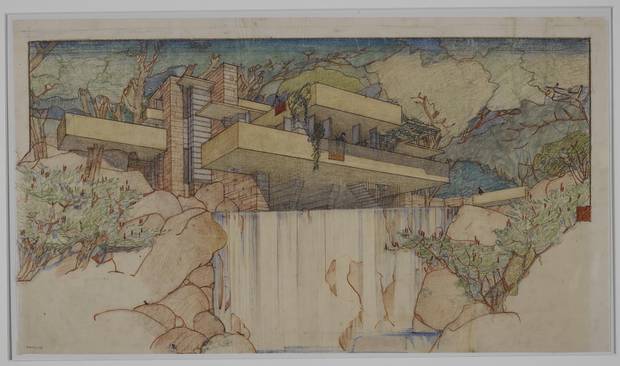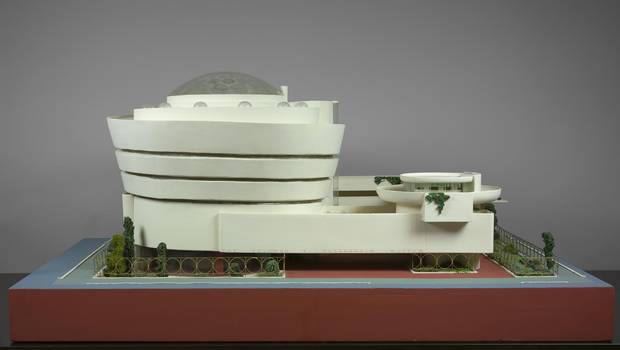To this day, Frank Lloyd Wright endures as maybe the most iconic architect of the 20th century – a starchitect, before such a term existed.
All this year, fans of the prolific and contradictory figure, who gave the world Fallingwater (and by extension, the Fallingwater LEGO model), the Solomon R. Guggenheim Museum, the School of Architecture at Taliesin, the Broadacre City model for suburban living (and gave Ayn Rand the inspiration for The Fountainhead protagonist Howard Roark), can celebrate the architect's sesquicentennial with events, symposia, exhibitions and public viewings of his buildings – some of which have been newly restored.
In on the hoopla, but honouring the architect's legacy in its own way, New York's Museum of Modern Art has mounted an ambitious exhibition of materials, ephemera and interpretations from Wright's extensive archive. Frank Lloyd Wright at 150: Unpacking the Archive opened June 8, Wright's 150th birthday, and positions the architect as a consummate innovator – not outside of history, but very much of his time, with ideas that resonate still.

Fallingwater
The Frank Lloyd Wright Foundation Archives, the Museum of Modern Art
Structured as an "anthology" rather than a monographic presentation, the show is divided into 12 sections that interrogate select objects from the Frank Lloyd Wright Foundation Archives, recently consolidated and transferred to MoMA and the Avery Architectural and Fine Arts Library at Columbia University. MoMA curator and exhibition organizer Barry Bergdoll says the exhibition points to a new direction in showcasing Wright.
"If you look at the scores of books that come out about Wright every year, they're almost always just about Wright. They're not about him in relationship to other practitioners, larger movements or questions of the day, be they architectural, political, economic or social, despite the fact that he had very trenchant views on all of these," Bergdoll says.
The exhibition invites people with interesting perspectives to begin to use the archive, says Bergdoll, and tackles themes that are pressing within a contemporary context, including ecology, race relations, urban density, DIY-building systems and the celebrity status of architects (Frank Lloyd Wright was famously famous in his day, appearing on game shows and the cover of Time magazine in 1938).
Among the approximately 450 architectural drawings, models, building fragments, films, television broadcasts and photos that make up the exhibition, visitors can delight at pencil-crayon-on-trace renders of iconic, obscure and international projects, painstakingly annotated planting plans, remarkable ornamental pattern details and a carefully restored presentation model of St. Mark's towers, stocked with tiny mint-coloured pianos, decorative screens and furniture designed by Wright for the glass skyscraper residence that was commissioned in 1927 but never built.
Visitors will miss the monumentally scaled Broadacre City model, but happily, it will be on view in September as part of a sibling exhibition at the new Renzo Piano-designed Lenfest Center for the Arts at Columbia University's new West Harlem campus – setting Wright's decentralized utopia against contemporaneous public housing projects.
Exhibiting and experiencing architecture in a museum environment can be a challenge, but the MoMA exhibition and the themes explored therein are a worthwhile companion to experiencing Wright's spaces. "You could call it… an 'owner's manual' for a future visit," says Bergdoll. "And of course, visitors who come here to the see the exhibition can see a major Wright building very rapidly. The Guggenheim Museum is only about a 20-minute walk away."
The MoMA exhibition and nearby Guggenheim are just two of many must-sees for Wright enthusiasts this year. The Frank Lloyd Wright Foundation is organizing festivities at properties across the United States, including tours of the newly restored Unity Temple in Chicago, Buffalo's Darwin Martin House Complex and Taliesin and Taliesin West, the original homes and sites of Wright's educational institute, in Spring Green, Wis. and Scottsdale, Ariz.

Solomon R. Guggenheim Museum
Avery Architectural & Fine Arts Library, Columbia University
Aaron Betsky, dean of the School of Architecture at Taliesin, the apprenticeship-based experiment in architectural education and communal living that Wright established in 1932, says that to experience Wright is to "understand how architecture can frame your relationship to other human beings and the world around you." In his proposals to deal with sprawl, engage with landscape and create organic architecture "he was certainly the most important and most experimental architect in America," he adds. "[Wright] set forth models and created types that reverberate through American and world architecture to an astonishing degree."
Even in his personal bathroom at Taliesin West, which Betsky invites visitors to have a look at – the architect redesigned it before his death in 1959 to resemble an air-stream trailer, aluminum panelling, slick detailing and all. "That was Frank Lloyd Wright," says Betsky. "He was innovating all the way until he died."
Frank Lloyd Wright at 150: Unpacking the Archive is on view at the Museum of Modern Art in New York City until Oct. 1, 2017. Living in America: Frank Lloyd Wright, Harlem, and Modern Housing will be on view at the The Wallach Art Gallery at Columbia University's Manhattanville campus from Sept. 8 to Dec. 17, 2017. Other Frank Lloyd Wright sesquicentennial events can be found at www.FLW150.com.
Visit tgam.ca/newsletters to sign up for the Globe Style e-newsletter, your weekly digital guide to the players and trends influencing fashion, design and entertaining, plus shopping tips and inspiration for living well. And follow Globe Style on Instagram @globestyle.

